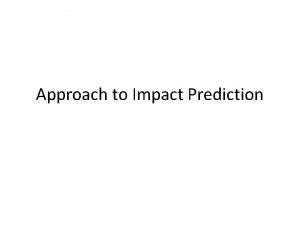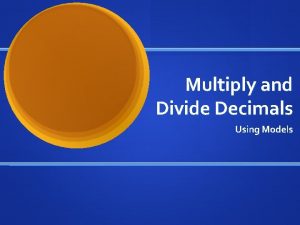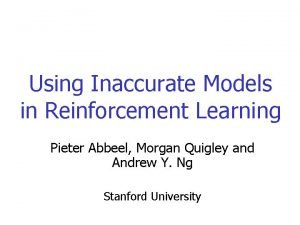Using the models prediction deciding Peter Fox Data





![pairs(iris[1: 4], main = "Anderson's Iris Data -- 3 species”, pch = 21, bg pairs(iris[1: 4], main = "Anderson's Iris Data -- 3 species”, pch = 21, bg](https://slidetodoc.com/presentation_image_h2/9bb37255a6968f9149012fac6f1c9d12/image-6.jpg)
![splom extra! require(lattice) super. sym <- trellis. par. get("superpose. symbol") splom(~iris[1: 4], groups = splom extra! require(lattice) super. sym <- trellis. par. get("superpose. symbol") splom(~iris[1: 4], groups =](https://slidetodoc.com/presentation_image_h2/9bb37255a6968f9149012fac6f1c9d12/image-7.jpg)
![parallelplot(~iris[1: 4] | Species, iris) 8 parallelplot(~iris[1: 4] | Species, iris) 8](https://slidetodoc.com/presentation_image_h2/9bb37255a6968f9149012fac6f1c9d12/image-8.jpg)
![parallelplot(~iris[1: 4], iris, groups = Species, horizontal. axis = FALSE, scales = list(x = parallelplot(~iris[1: 4], iris, groups = Species, horizontal. axis = FALSE, scales = list(x =](https://slidetodoc.com/presentation_image_h2/9bb37255a6968f9149012fac6f1c9d12/image-9.jpg)






![> pfit. K<- prune(fit. K, cp= fit. K$cptable[which. min(fit. K$cptable[, "xerror"]), "CP"]) > plot(pfit. > pfit. K<- prune(fit. K, cp= fit. K$cptable[which. min(fit. K$cptable[, "xerror"]), "CP"]) > plot(pfit.](https://slidetodoc.com/presentation_image_h2/9bb37255a6968f9149012fac6f1c9d12/image-16.jpg)










![Bayes > cl <- kmeans(iris[, 1: 4], 3) > table(cl$cluster, iris[, 5]) setosa versicolor Bayes > cl <- kmeans(iris[, 1: 4], 3) > table(cl$cluster, iris[, 5]) setosa versicolor](https://slidetodoc.com/presentation_image_h2/9bb37255a6968f9149012fac6f1c9d12/image-27.jpg)
![Digging into iris classifier<-naive. Bayes(iris[, 1: 4], iris[, 5]) table(predict(classifier, iris[, -5]), iris[, 5], Digging into iris classifier<-naive. Bayes(iris[, 1: 4], iris[, 5]) table(predict(classifier, iris[, -5]), iris[, 5],](https://slidetodoc.com/presentation_image_h2/9bb37255a6968f9149012fac6f1c9d12/image-28.jpg)
![Digging into iris > classifier$apriori iris[, 5] setosa versicolor virginica 50 50 50 > Digging into iris > classifier$apriori iris[, 5] setosa versicolor virginica 50 50 50 >](https://slidetodoc.com/presentation_image_h2/9bb37255a6968f9149012fac6f1c9d12/image-29.jpg)


![House Votes 1984 > predict(model, House. Votes 84[1: 10, -1], type = "raw") democrat House Votes 1984 > predict(model, House. Votes 84[1: 10, -1], type = "raw") democrat](https://slidetodoc.com/presentation_image_h2/9bb37255a6968f9149012fac6f1c9d12/image-32.jpg)
![House Votes 1984 > pred <- predict(model, House. Votes 84[, -1]) > table(pred, House. House Votes 1984 > pred <- predict(model, House. Votes 84[, -1]) > table(pred, House.](https://slidetodoc.com/presentation_image_h2/9bb37255a6968f9149012fac6f1c9d12/image-33.jpg)




- Slides: 37

Using the models, prediction, deciding Peter Fox Data Analytics – ITWS-4963/ITWS-6965 Week 7 b, March 7, 2014 1

scatterplot. Matrix 2

Hierarchical clustering > dswiss <- dist(as. matrix(swiss)) > hs <- hclust(dswiss) > plot(hs) 3

ctree require(party) swiss_ctree <- ctree(Fertility ~ Agriculture + Education + Catholic, data = swiss) plot(swiss_ctree) 4

5
![pairsiris1 4 main Andersons Iris Data 3 species pch 21 bg pairs(iris[1: 4], main = "Anderson's Iris Data -- 3 species”, pch = 21, bg](https://slidetodoc.com/presentation_image_h2/9bb37255a6968f9149012fac6f1c9d12/image-6.jpg)
pairs(iris[1: 4], main = "Anderson's Iris Data -- 3 species”, pch = 21, bg = c("red", "green 3", "blue")[unclass(iris$Species)]) 6
![splom extra requirelattice super sym trellis par getsuperpose symbol splomiris1 4 groups splom extra! require(lattice) super. sym <- trellis. par. get("superpose. symbol") splom(~iris[1: 4], groups =](https://slidetodoc.com/presentation_image_h2/9bb37255a6968f9149012fac6f1c9d12/image-7.jpg)
splom extra! require(lattice) super. sym <- trellis. par. get("superpose. symbol") splom(~iris[1: 4], groups = Species, data = iris, panel = panel. superpose, key = list(title = "Three Varieties of Iris", columns = 3, points = list(pch = super. sym$pch[1: 3], col = super. sym$col[1: 3]), text = list(c("Setosa", "Versicolor", "Virginica")))) splom(~iris[1: 3]|Species, data = iris, layout=c(2, 2), pscales = 0, varnames = c("Sepaln. Length", "Sepaln. Width", "Petaln. Length"), page = function(. . . ) { ltext(x = seq(. 6, . 8, length. out = 4), y = seq(. 9, . 6, length. out = 4), labels = c("Three", "Varieties", "of", "Iris"), cex = 2) }) 7
![parallelplotiris1 4 Species iris 8 parallelplot(~iris[1: 4] | Species, iris) 8](https://slidetodoc.com/presentation_image_h2/9bb37255a6968f9149012fac6f1c9d12/image-8.jpg)
parallelplot(~iris[1: 4] | Species, iris) 8
![parallelplotiris1 4 iris groups Species horizontal axis FALSE scales listx parallelplot(~iris[1: 4], iris, groups = Species, horizontal. axis = FALSE, scales = list(x =](https://slidetodoc.com/presentation_image_h2/9bb37255a6968f9149012fac6f1c9d12/image-9.jpg)
parallelplot(~iris[1: 4], iris, groups = Species, horizontal. axis = FALSE, scales = list(x = list(rot = 90))) 9

hclust for iris 10

plot(iris_ctree) 11

Ctree > iris_ctree <- ctree(Species ~ Sepal. Length + Sepal. Width + Petal. Length + Petal. Width, data=iris) > print(iris_ctree) Conditional inference tree with 4 terminal nodes Response: Species Inputs: Sepal. Length, Sepal. Width, Petal. Length, Petal. Width Number of observations: 150 1) Petal. Length <= 1. 9; criterion = 1, statistic = 140. 264 2)* weights = 50 1) Petal. Length > 1. 9 3) Petal. Width <= 1. 7; criterion = 1, statistic = 67. 894 4) Petal. Length <= 4. 8; criterion = 0. 999, statistic = 13. 865 5)* weights = 46 4) Petal. Length > 4. 8 6)* weights = 8 3) Petal. Width > 1. 7 7)* weights = 46 12

> plot(iris_ctree, type="simple”) 13

New dataset to work with trees fit. K <- rpart(Kyphosis ~ Age + Number + Start, method="class", data=kyphosis) printcp(fit. K) # display the results plotcp(fit. K) # visualize cross-validation results summary(fit. K) # detailed summary of splits # plot tree plot(fit. K, uniform=TRUE, main="Classification Tree for Kyphosis") text(fit. K, use. n=TRUE, all=TRUE, cex=. 8) # create attractive postscript plot of tree post(fit. K, file = “kyphosistree. ps", title = "Classification Tree for Kyphosis") # might need to convert to PDF (distill) 14

15
![pfit K prunefit K cp fit Kcptablewhich minfit Kcptable xerror CP plotpfit > pfit. K<- prune(fit. K, cp= fit. K$cptable[which. min(fit. K$cptable[, "xerror"]), "CP"]) > plot(pfit.](https://slidetodoc.com/presentation_image_h2/9bb37255a6968f9149012fac6f1c9d12/image-16.jpg)
> pfit. K<- prune(fit. K, cp= fit. K$cptable[which. min(fit. K$cptable[, "xerror"]), "CP"]) > plot(pfit. K, uniform=TRUE, main="Pruned Classification Tree for Kyphosis") 16 > text(pfit. K, use. n=TRUE, all=TRUE, cex=. 8) > post(pfit. K, file = “ptree. ps", title = "Pruned Classification Tree for Kyphosis”)

> fit. K <- ctree(Kyphosis ~ Age + Number + Start, data=kyphosis) > plot(fit. K, main="Conditional Inference Tree for Kyphosis”) 17

> plot(fit. K, main="Conditional Inference Tree for Kyphosis", type="simple") 18

random. Forest > require(random. Forest) > fit. KF <- random. Forest(Kyphosis ~ Age + Number + Start, data=kyphosis) > print(fit. KF) # view results Call: random. Forest(formula = Kyphosis ~ Age + Number + Start, data = kyphosis) Type of random forest: classification Number of trees: 500 No. of variables tried at each split: 1 OOB estimate of error rate: 20. 99% Confusion matrix: absent present class. error absent 59 5 0. 0781250 present 12 5 0. 7058824 > importance(fit. KF) # importance of each predictor Mean. Decrease. Gini Age 8. 654112 Number 5. 584019 Start 10. 168591 Random forests improve predictive accuracy by generating a large number of bootstrapped trees (based on random samples of variables), classifying a case using each tree in this new "forest", and deciding a final predicted outcome by combining the results across all of the trees 19 (an average in regression, a majority vote in classification).

More on another dataset. # Regression Tree Example library(rpart) # build the tree fit. M <- rpart(Mileage~Price + Country + Reliability + Type, method="anova", data=cu. summary) printcp(fit. M) # display the results …. Root node error: 1354. 6/60 = 22. 576 n=60 (57 observations deleted due to missingness) CP nsplit rel error xstd 1 0. 622885 0 1. 00000 1. 03165 0. 176920 2 0. 132061 1 0. 37711 0. 51693 0. 102454 3 0. 025441 2 0. 24505 0. 36063 0. 079819 4 0. 011604 3 0. 21961 0. 34878 0. 080273 5 0. 010000 4 0. 20801 0. 36392 0. 075650 20

Mileage… plotcp(fit. M) # visualize cross-validation results summary(fit. M) # detailed summary of splits <we will leave this for Friday to look at> 21

par(mfrow=c(1, 2)) rsq. rpart(fit. M) # visualize cross-validation results 22

# plot tree plot(fit. M, uniform=TRUE, main="Regression Tree for Mileage ") text(fit. M, use. n=TRUE, all=TRUE, cex=. 8) # prune the tree pfit. M<- prune(fit. M, cp=0. 01160389) # from cptable # plot the pruned tree plot(pfit. M, uniform=TRUE, main="Pruned Regression Tree for Mileage") text(pfit. M, use. n=TRUE, all=TRUE, cex=. 8) post(pfit. M, file = ”ptree 2. ps", title = "Pruned Regression Tree for Mileage”) 23

24

# Conditional Inference Tree for Mileage fit 2 M <- ctree(Mileage~Price + Country + Reliability + Type, data=na. omit(cu. summary)) 25

Enough of trees! 26
![Bayes cl kmeansiris 1 4 3 tableclcluster iris 5 setosa versicolor Bayes > cl <- kmeans(iris[, 1: 4], 3) > table(cl$cluster, iris[, 5]) setosa versicolor](https://slidetodoc.com/presentation_image_h2/9bb37255a6968f9149012fac6f1c9d12/image-27.jpg)
Bayes > cl <- kmeans(iris[, 1: 4], 3) > table(cl$cluster, iris[, 5]) setosa versicolor virginica 2 0 2 36 1 0 48 14 3 50 0 0 # > m <- naive. Bayes(iris[, 1: 4], iris[, 5]) > table(predict(m, iris[, 1: 4]), iris[, 5]) setosa versicolor virginica setosa 50 0 0 versicolor 0 47 3 virginica 0 3 47 pairs(iris[1: 4], main="Iris Data (red=setosa, green=versicolor , blue=virginica)", pch=21, bg=c("red", "green 3", "blue")[u nclass(iris$Species)]) 27
![Digging into iris classifiernaive Bayesiris 1 4 iris 5 tablepredictclassifier iris 5 iris 5 Digging into iris classifier<-naive. Bayes(iris[, 1: 4], iris[, 5]) table(predict(classifier, iris[, -5]), iris[, 5],](https://slidetodoc.com/presentation_image_h2/9bb37255a6968f9149012fac6f1c9d12/image-28.jpg)
Digging into iris classifier<-naive. Bayes(iris[, 1: 4], iris[, 5]) table(predict(classifier, iris[, -5]), iris[, 5], dnn=list('predicted', 'actual')) actual predicted setosa versicolor virginica setosa 50 0 0 versicolor 0 47 3 virginica 0 3 47 28
![Digging into iris classifierapriori iris 5 setosa versicolor virginica 50 50 50 Digging into iris > classifier$apriori iris[, 5] setosa versicolor virginica 50 50 50 >](https://slidetodoc.com/presentation_image_h2/9bb37255a6968f9149012fac6f1c9d12/image-29.jpg)
Digging into iris > classifier$apriori iris[, 5] setosa versicolor virginica 50 50 50 > classifier$tables$Petal. Length iris[, 5] [, 1] [, 2] setosa 1. 462 0. 1736640 versicolor 4. 260 0. 4699110 virginica 5. 552 0. 5518947 29

Digging into iris plot(function(x) dnorm(x, 1. 462, 0. 1736640), 0, 8, col="red", main="Petal length distribution for the 3 different species") curve(dnorm(x, 4. 260, 0. 4699110), add=TRUE, col="blue") curve(dnorm(x, 5. 552, 0. 5518947 ), add=TRUE, col = "green") 30

http: //www. ugrad. stat. ubc. ca/R/library/mlb ench/html/House. Votes 84. html > require(mlbench) > data(House. Votes 84) > model <- naive. Bayes(Class ~. , data = House. Votes 84) > predict(model, House. Votes 84[1: 10, -1]) [1] republican democrat republican [10] democrat Levels: democrat republican 31
![House Votes 1984 predictmodel House Votes 841 10 1 type raw democrat House Votes 1984 > predict(model, House. Votes 84[1: 10, -1], type = "raw") democrat](https://slidetodoc.com/presentation_image_h2/9bb37255a6968f9149012fac6f1c9d12/image-32.jpg)
House Votes 1984 > predict(model, House. Votes 84[1: 10, -1], type = "raw") democrat republican [1, ] 1. 029209 e-07 9. 999999 e-01 [2, ] 5. 820415 e-08 9. 999999 e-01 [3, ] 5. 684937 e-03 9. 943151 e-01 [4, ] 9. 985798 e-01 1. 420152 e-03 [5, ] 9. 666720 e-01 3. 332802 e-02 [6, ] 8. 121430 e-01 1. 878570 e-01 [7, ] 1. 751512 e-04 9. 998248 e-01 [8, ] 8. 300100 e-06 9. 999917 e-01 [9, ] 8. 277705 e-08 9. 999999 e-01 32 [10, ] 1. 000000 e+00 5. 029425 e-11
![House Votes 1984 pred predictmodel House Votes 84 1 tablepred House House Votes 1984 > pred <- predict(model, House. Votes 84[, -1]) > table(pred, House.](https://slidetodoc.com/presentation_image_h2/9bb37255a6968f9149012fac6f1c9d12/image-33.jpg)
House Votes 1984 > pred <- predict(model, House. Votes 84[, -1]) > table(pred, House. Votes 84$Class) pred democrat republican democrat 238 13 republican 29 155 33

So now you could complete this: > data(Hair. Eye. Color) > mosaicplot(Hair. Eye. Color) > margin. table(Hair. Eye. Color, 3) Sex Male Female 279 313 > margin. table(Hair. Eye. Color, c(1, 3)) Sex Hair Male Female Black 56 52 Brown 143 Red 34 37 Blond 46 81 Construct a naïve Bayes classifier and test. 34

Assignments to come… • Term project (A 6). Due ~ week 13. 30% (25% written, 5% oral; individual). • Assignment 7: Predictive and Prescriptive Analytics. Due ~ week 9/10. 20% (15% written and 5% oral; individual); 35

Coming weeks • I will be out of town Friday March 21 and 28 • On March 21 you will have a lab – attendance will be taken – to work on assignments (term (6) and assignment 7). Your project proposals (Assignment 5) are on March 18. • On March 28 you will have a lecture on SVM, thus the Tuesday March 25 will be a lab. • Back to regular schedule in April (except 18 th) 36

Admin info (keep/ print this slide) • • • Class: ITWS-4963/ITWS 6965 Hours: 12: 00 pm-1: 50 pm Tuesday/ Friday Location: SAGE 3101 Instructor: Peter Fox Instructor contact: pfox@cs. rpi. edu, 518. 276. 4862 (do not leave a msg) Contact hours: Monday** 3: 00 -4: 00 pm (or by email appt) Contact location: Winslow 2120 (sometimes Lally 207 A announced by email) TA: Lakshmi Chenicheri chenil@rpi. edu Web site: http: //tw. rpi. edu/web/courses/Data. Analytics/2014 – Schedule, lectures, syllabus, reading, assignments, etc. 37
 Mathematical models for impact prediction
Mathematical models for impact prediction Stealing machine learning models via prediction apis
Stealing machine learning models via prediction apis Stealing machine learning models via prediction apis
Stealing machine learning models via prediction apis Rpi data science
Rpi data science Peter fox schwarz zu blau text
Peter fox schwarz zu blau text Deciding to marry asl story
Deciding to marry asl story Batasan perencanaan
Batasan perencanaan Planning is deciding in advance what is to be done
Planning is deciding in advance what is to be done Deciding on the global marketing organization
Deciding on the global marketing organization What is this image
What is this image What spooked jem on the night of the radley
What spooked jem on the night of the radley Semi modals
Semi modals Senge mental models
Senge mental models Using recursion in models and decision making
Using recursion in models and decision making Using functions in models and decision making
Using functions in models and decision making Dividing decimals using models
Dividing decimals using models Lesson 3 using economic models
Lesson 3 using economic models Algebraic model example
Algebraic model example Using inaccurate models in reinforcement learning
Using inaccurate models in reinforcement learning Peter voulkos, gallas rock is made using
Peter voulkos, gallas rock is made using Hình ảnh bộ gõ cơ thể búng tay
Hình ảnh bộ gõ cơ thể búng tay Slidetodoc
Slidetodoc Bổ thể
Bổ thể Tỉ lệ cơ thể trẻ em
Tỉ lệ cơ thể trẻ em Voi kéo gỗ như thế nào
Voi kéo gỗ như thế nào Chụp phim tư thế worms-breton
Chụp phim tư thế worms-breton Bài hát chúa yêu trần thế alleluia
Bài hát chúa yêu trần thế alleluia Kể tên các môn thể thao
Kể tên các môn thể thao Thế nào là hệ số cao nhất
Thế nào là hệ số cao nhất Các châu lục và đại dương trên thế giới
Các châu lục và đại dương trên thế giới Công thức tính độ biến thiên đông lượng
Công thức tính độ biến thiên đông lượng Trời xanh đây là của chúng ta thể thơ
Trời xanh đây là của chúng ta thể thơ Mật thư anh em như thể tay chân
Mật thư anh em như thể tay chân Phép trừ bù
Phép trừ bù độ dài liên kết
độ dài liên kết Các châu lục và đại dương trên thế giới
Các châu lục và đại dương trên thế giới Thơ thất ngôn tứ tuyệt đường luật
Thơ thất ngôn tứ tuyệt đường luật Quá trình desamine hóa có thể tạo ra
Quá trình desamine hóa có thể tạo ra





























































